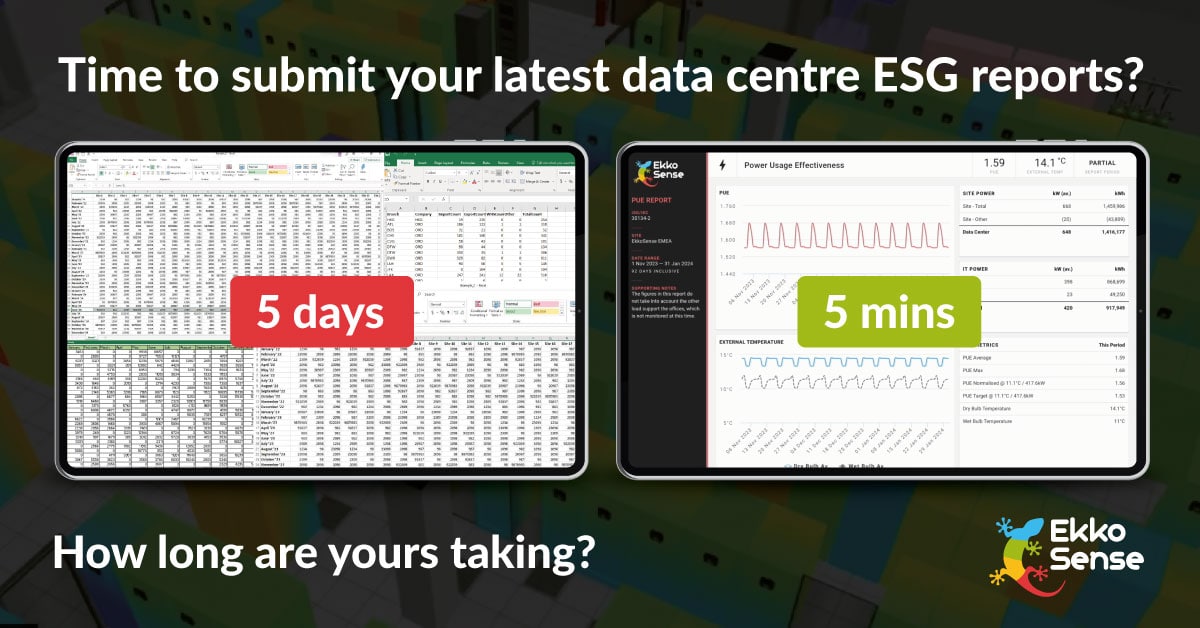Automating data centre reporting to rescue operations teams from the continuous data search and report cycle

Matthew Farnell explains how he enjoys helping data centre operators to unlock intangible benefits from their data centre monitoring investment through the added benefit of being able to automate data centre reporting (including data centre ESG reporting) – solving many manual and repetitive data collection tasks
The common use of data centre optimisation software is to remove thermal and power risks or cut a data centre operator’s cooling energy costs. However, it’s often the more intangible benefits that can really make a difference. One of the areas I find resonates most with data centre operations teams is automated data centre reporting.
Given the amazing, transformative software applications that make up the compute workloads of today’s data centres, it’s surprising that so many key reporting processes still rely on traditional manual data collection and spreadsheets. This outdated approach not only strains time and resources, but can also be frustrating for the skilled employees required to produce the data centre reports.
Take a theoretically standard task such as establishing your data centre’s current PUE score. It’s surprising how many operations teams can’t actually say what theirs is! Many managers just don’t have immediate access to this key data centre reporting information. In my experience finding this metric typically involves pulling together all the necessary BMS or EPMS metrics, and then working through all the calculations using a potentially error-prone spreadsheet. That’s all just for one measurement.
With the expanding requirement for data centre ESG reporting to satisfy the growth of energy efficiency and sustainability reporting regulations at a company wide level, things now get much more complicated. We’re quickly seeing ESG’s impact evolve from being a largely corporate and social responsibility issue to becoming a core compliance challenge for data centre operators.
It’s not just a European issue either. ESG’s emphasis was initially on Europe with the European Union’s Corporate Sustainability Reporting Directive (CSRD), and the European Commission’s Energy Efficiency Directive (EED). Now it’s becoming a global initiative, especially with the introduction of California’s SB 253 Climate Corporate Data Accountability Act that – even though it was amended and delayed by further SB 291 changes – will become law in July 2025. We’re also seeing a similar trend in the Asia Pacific region with Singapore’s Green Mark DC Platinum Certification, as well as the new mandatory climate-related reporting requirements passed last month by Australia’s House of Representatives.
While PUE remains a key metric for data centre ESG reporting, it’s just one in a series of measurements that are needed to present a more rounded view of a sustainable data centre’s performance. In addition to PUE, the ISO/IEC 30134 series of standardised data centre resource efficiency KPIs include a Cooling Efficiency Ratio (CER), a Carbon Usage Effectiveness measure (CUE) and a Water Usage Effectiveness metric (WUE). Other relevant elements include an Energy Reuse Factor (ERF) and a Renewable Energy Factor (REF). Together, these ISO/IEC 30134 measurements provide a valuable foundation for organisations seeking to measure their ESG Scope 2 performance.
Given that data centre ESG reporting has now become a critical part of our industry’s compliance mix, what’s the likely impact going to be for operations teams? We’ve already seen how simply collecting a PUE measurement can be over complicated, time consuming and challenging. What happens when you’re tasked with gathering 5-10 different metrics on an ongoing basis just to remain compliant?
We’re already seeing some of the larger operators requiring teams of five or six people just to go round and collect the basic data. This all then has to be entered into spreadsheets and various calculations applied before you can even start on your data centre ESG reporting. From a management perspective this is highly inefficient and risk-prone – and that’s before you consider the implications of having too many of your talented data centre operations people tied up with routine data collection on a continuous cycle. That’s why there’s such a need to automate data centre ESG reporting.
In my role I’m working with data centre operators who are using software to optimise performance and reduce carbon with quantificable data centre cooling savings. However, one of the key intangible benefits we are delivering comes through our automated ESG data center reporting capability. Because we collect all the real-time granular performance data needed for global data centre ESG reporting, operations teams no longer need to spend multiple days each month gathering basic compliance data. Problem solved! That’s good news from both a company’s efficiency perspective and also a relief to all the data centre operations team members to rescue them from the continuous resporting cycle. Sometimes it’s the intangible benefits that can make all the difference.
Get in touch with Matthew for more advice or you may find these 1 minute Tech Tip videos below of interest to show you how to solve your data centre reporting challenges.
Take the hard work out of your scheduled reports
Simple, easy-to-use ESG data center reporting is just a minute away